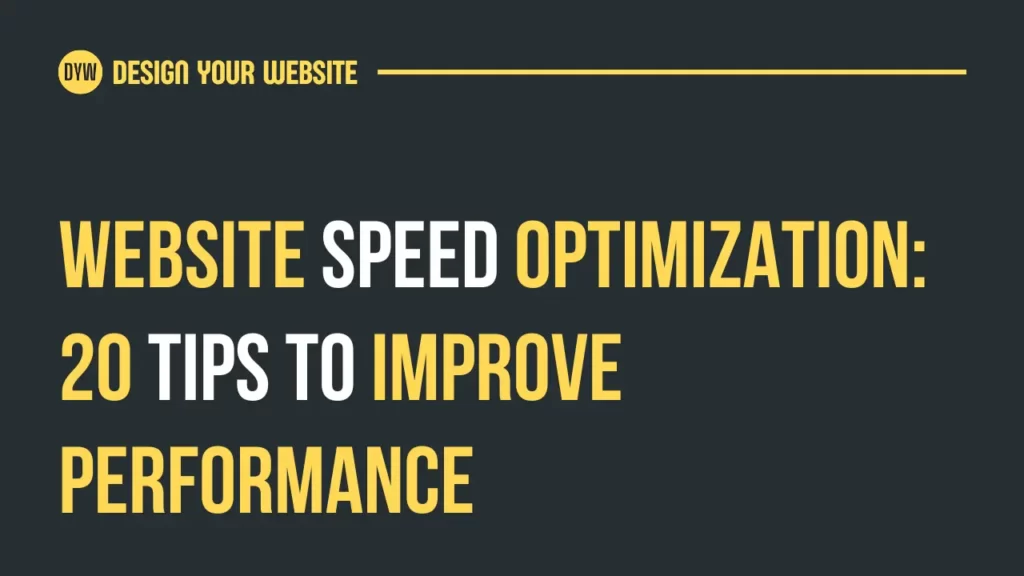Website Speed Optimization – Introduction
In today’s digital landscape, speed is crucial for website success. Users expect fast-loading websites, and search engines prioritize speedy sites in their rankings. This blog post aims to provide you with 20 effective tips to optimize your website’s speed, ensuring optimal performance and enhanced user experience.

Why Page Speed Matters
Page speed plays a vital role in user satisfaction, conversion rates, and overall business success. Slow-loading websites frustrate users, leading to high bounce rates and decreased engagement. Conversely, fast-loading sites improve user experience, boost conversions, and even contribute to higher search engine rankings.
Factors Affecting Site Speed
Several factors impact a website’s speed. These include server response time, large file sizes, excessive HTTP requests, unoptimized code, and third-party scripts or plugins. By addressing these factors, you can significantly enhance your site’s performance.
Measuring Website Speed
Measuring website speed is crucial since it provides valuable insights into performance improvements. Tools like GTmetrix and Google PageSpeed Insights can help you analyze your site’s speed, identify bottlenecks, and pinpoint areas for optimization.
The Significance of Measurement
Measuring website speed enables you to track your progress and ensure that your optimizations are effective. It allows you to set performance goals and evaluate your site’s speed against industry benchmarks and user expectations.

Core Web Vitals: Metrics for Evaluation
Core Web Vitals are essential metrics for evaluating your website’s performance. These metrics include Largest Contentful Paint (LCP), First Input Delay (FID), and Cumulative Layout Shift (CLS). Optimizing these metrics improves the overall user experience.
Monitoring Tools: Sematext Synthetics and Sematext Experience
Tools like Sematext Synthetics and Sematext Experience can help monitor and analyze your website’s performance. They provide real-time monitoring, alerting, and comprehensive reports to ensure that your site consistently delivers a fast and seamless user experience.
Setting Performance Goals
Setting clear performance goals is crucial for website speed optimization. Determine key metrics, such as page load time or Core Web Vitals thresholds, that align with your user expectations and business objectives.
Defining Good Website Speed
Good website speed is characterized by fast page load times and optimized Core Web Vitals metrics. It ensures quick interactions and smooth content delivery, resulting in improved user engagement and conversions.
Core Web Vitals Thresholds
To meet Core Web Vitals thresholds, strive for an LCP of 2.5 seconds or less, FID of 100 milliseconds or less, and CLS of 0.1 or less. Achieving these thresholds ensures a positive user experience and supports your website’s performance goals.
Best Practices for Website Speed Optimization
- Reduce the Number of HTTP Requests: Identify and minimize unnecessary requests to reduce loading time.
- Minimize External Resources: Limit the use of external scripts and resources that may slow down your site.
- Switch to HTTP/2: Adopt HTTP/2 to benefit from improved speed, efficiency, and multiplexing capabilities.
- Optimize Image Sizes: Compress and resize images to reduce their file sizes without compromising quality.
- Implement Content Delivery Network (CDN): Leverage a CDN to deliver content quickly to users worldwide.
- Write Mobile-First Code: Prioritize mobile optimization, ensuring seamless performance across devices.
- Minimize Time to First Byte (TTFB): Reduce server response time through caching, server optimizations, or a faster hosting provider.
- Choose the Right Hosting Service Plan: Evaluate hosting options to find a plan that offers adequate resources for your website’s needs.
- Implement Gzip Compression: Enable Gzip compression to reduce file sizes and speed up content delivery.
- Minify and Combine CSS, JavaScript, and HTML Files: Remove unnecessary characters and whitespace from code files, and combine them to minimize HTTP requests.
- Load JavaScript Asynchronously: Load JavaScript files asynchronously to prevent blocking the rendering of other page elements.
- Prefetch, Preconnect, and Prerender Techniques: Leverage resource hints to pre-fetch, pre-connect, and prerender critical assets for improved performance.
- Reduce the Number of Plugins: Limit plugin usage to only what is essential, as excessive plugins can impact site speed.
- Utilize Website Caching: Implement browser caching to store static content locally on users’ devices, reducing server requests.
- Adopt Cloud-Based Website Monitoring: Utilize cloud-based monitoring services to track performance, detect issues, and receive real-time alerts.
Importance of Monitoring
Monitoring your website’s performance is crucial to spot and address speed-related issues promptly. Regular monitoring helps ensure that your optimizations are effective and that your site maintains optimal speed and performance.
Benefits of Cloud-Based Monitoring
Cloud-based monitoring offers numerous benefits, including scalability, reliability, real-time monitoring, and comprehensive reporting. It allows you to track performance from various locations worldwide and easily identify potential bottlenecks.
Conclusion
Website speed optimization is key to delivering an exceptional user experience, achieving higher search engine rankings, and maximizing conversions. By implementing the 20 tips mentioned above, you can significantly improve your
Frequently asked questions about Website Speed Optimization
Q: What is website speed optimization?
A: Website speed optimization refers to the process of improving the loading speed and overall performance of a website. It involves implementing various techniques and best practices to reduce page load times and enhance user experience.
Q: Why is website speed important for my website?
A: Website speed is crucial as it directly impacts user experience, conversions, and search engine rankings. Faster-loading websites improve user satisfaction, reduce bounce rates, and have a higher likelihood of ranking well in search engine results.
Q: How can I measure my website’s speed?
A: You can measure your website’s speed using tools like Google PageSpeed Insights, GTmetrix, or Pingdom. These tools analyze your site, provide speed metrics, and offer suggestions for optimization.
Q: What are Core Web Vitals?
A: Core Web Vitals are a set of user-centric metrics introduced by Google to measure and evaluate website speed and user experience. These metrics include Largest Contentful Paint (LCP), First Input Delay (FID), and Cumulative Layout Shift (CLS).
Q: What are the best practices for website speed optimization?
A: Best practices for website speed optimization include reducing the number of HTTP requests, optimizing images and code files, utilizing content delivery networks (CDN), enabling browser caching, and minimizing the use of external scripts and plugins.
Q: How can I optimize images for improved website speed?
A: You can optimize images by compressing them without significant loss of quality, resizing them to appropriate dimensions, and using modern image formats such as WebP. Additionally, lazy loading images and leveraging responsive image techniques can further enhance website speed.
Q: What is browser caching and how does it help website speed?
A: Browser caching is a technique that allows static website files to be stored in the user’s browser for a specified period. When the user revisits the site, the files are loaded from the cache instead of the server, resulting in faster loading times.
Q: Is enabling Gzip compression beneficial for website speed?
A: Yes, enabling Gzip compression reduces the file size of your website’s resources (such as HTML, CSS, or JavaScript files) during transfer. This compression technique significantly reduces the amount of data that needs to be transmitted, leading to faster page load times.
Q: How can Content Delivery Networks (CDNs) help improve website speed?
A: CDNs distribute your website’s content across multiple servers worldwide. By storing copies of your website in various locations, CDNs reduce the distance between users and your site’s resources, resulting in faster content delivery and improved website speed.
Q: What role does website monitoring play in speed optimization?
A: Website monitoring helps track your website’s performance and identifies potential speed-related issues. By monitoring key metrics, such as page load times, TTFB (Time to First Byte), and uptime, you can proactively address any performance bottlenecks and ensure an optimized, fast-loading website.

